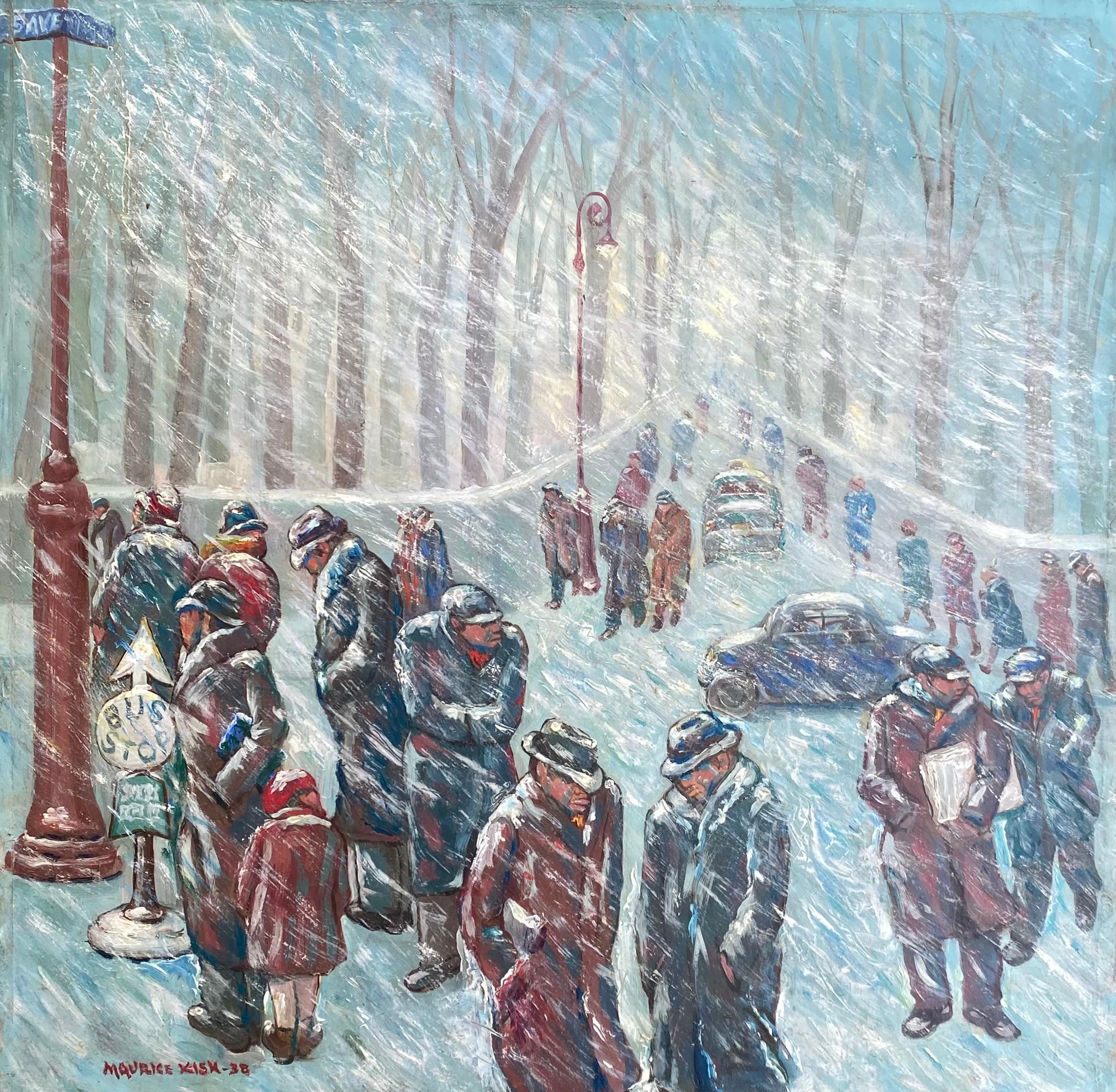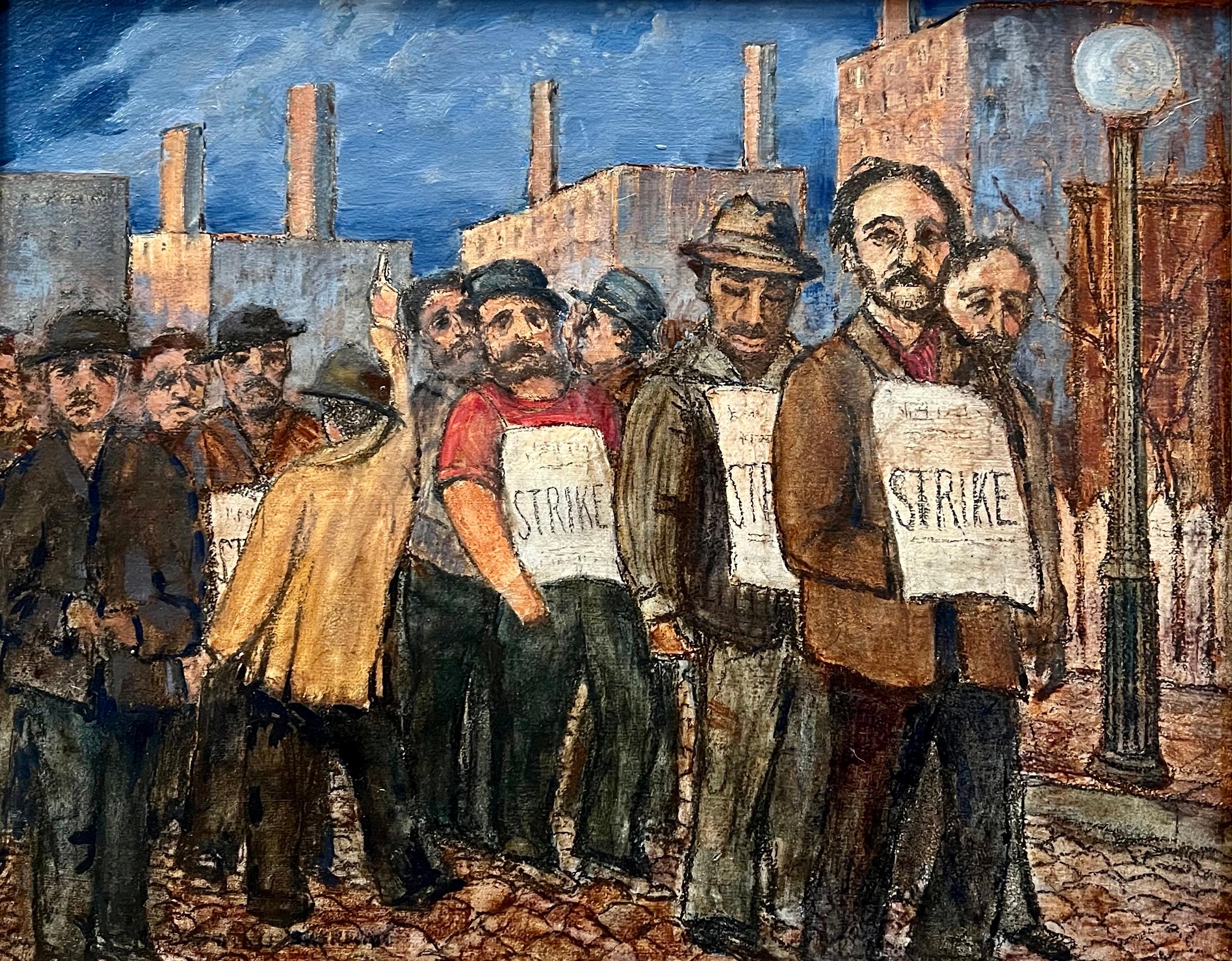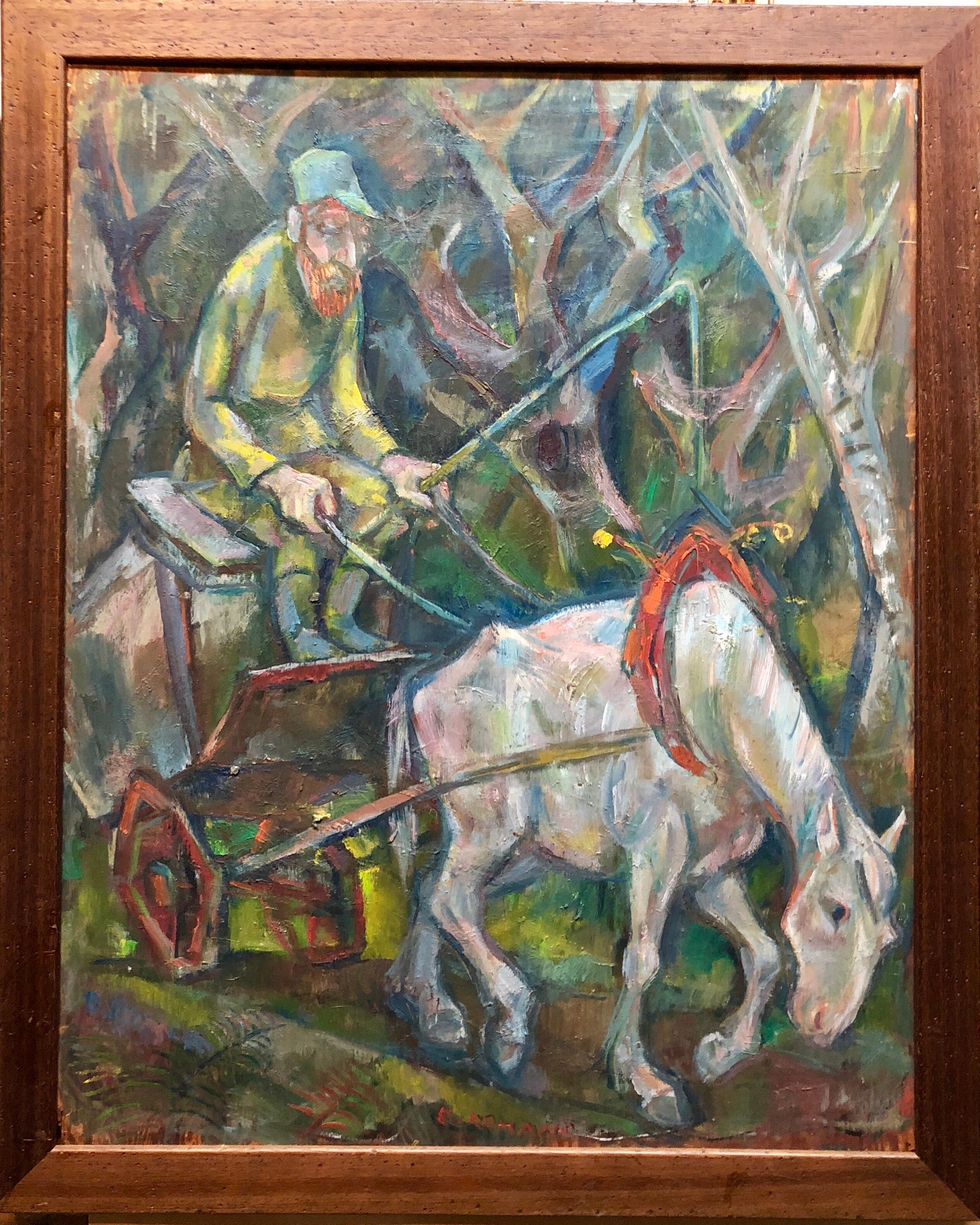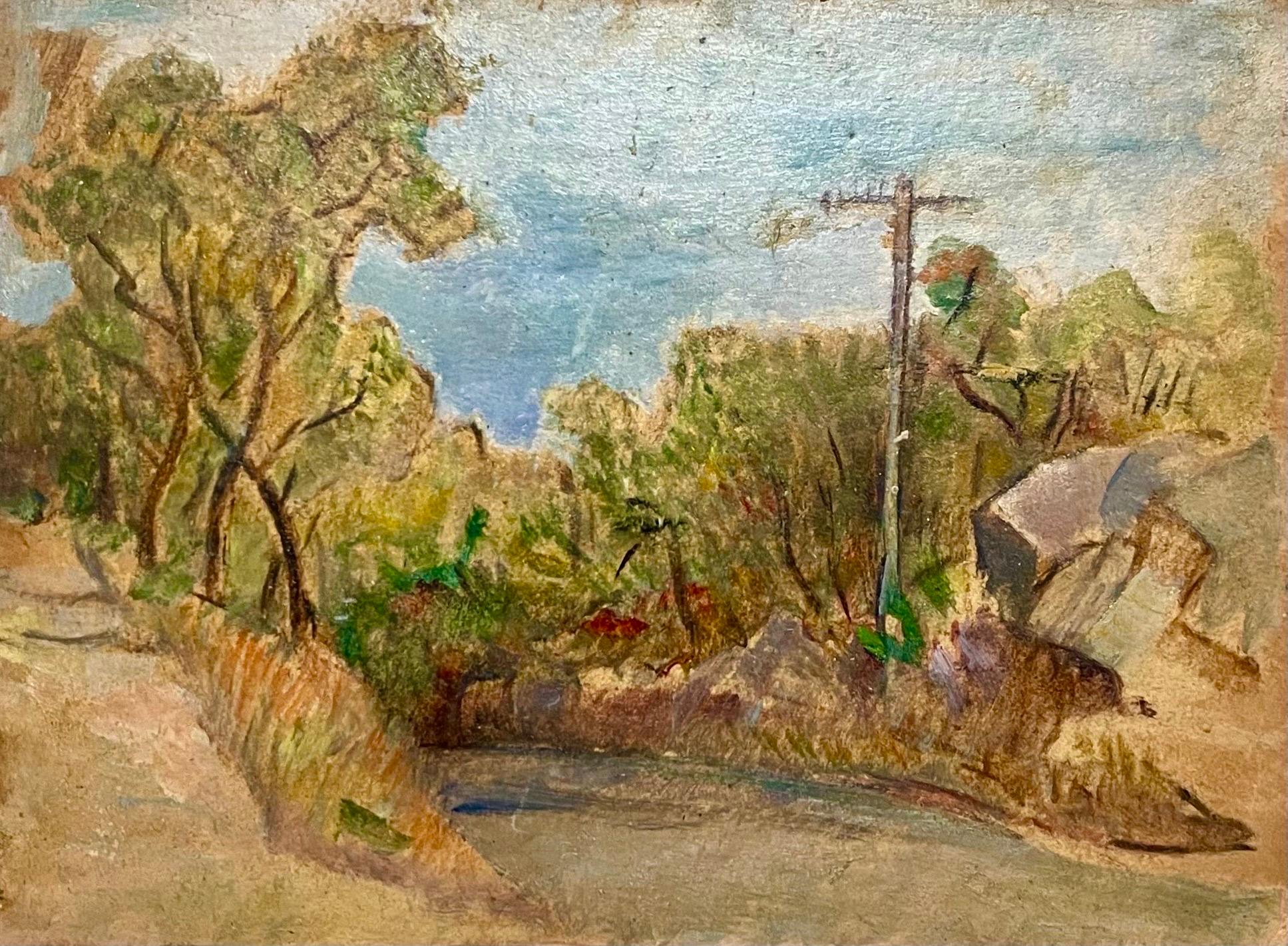Items Similar to "Industrial Cityscape, Chicago" WPA Modernism Mid-Century Cityscape 20th Century
Want more images or videos?
Request additional images or videos from the seller
1 of 8
Aaron Bohrod"Industrial Cityscape, Chicago" WPA Modernism Mid-Century Cityscape 20th Century1931
1931
About the Item
Midwestern Chicago artist Aaron Bohrod painted in 1931 this modernist industrial cityscape during the WPA of the 20th Century.
Aaron Bohrod (American 1907 – 1992), Industrial Cityscape, 20 x 16 inch, framed 27 x 23 inches, Oil on board, Signed lower right and verso, dated 1931. Carved vintage frame.
Known for a range of work in watercolor and gouache that included realist figures in cityscapes, landscapes, surrealism, and trompe l'oeil painting, Aaron Bohrod spent his early career in Chicago where he was born on the West Side.
In 1948, he moved to Madison, Wisconsin, where he became a long-time a member of the art faculty and satisfied the inclinations of many artists who leaned towards European-influenced modernism. In this university position, he replaced John Steuart Curry, Regionalist painter from Kansas, who had died. Many artists led by Surrealist Marshall Glasier thought Curry had been provincial and limited in subject matter and style.
In the late 1920's, Bohrod studied at the Art Institute of Chicago and then went to New York City to attend the Art Students League. He returned to his hometown in 1930 and resided there until the move to Wisconsin.
Influenced strongly by the Social Realism of John Sloan, whom he knew from New York, Bohrod painted city people, utilizing a wide array of styles ranging from a tight, detailed manner to one that was more abstract and sketch like. One of his subjects explored in a series of paintings was the neighborhood where he grew up on the North Side of Chicago. Many of them convey the loneliness and poverty of the Depression years.
He spent some time in the South Pacific during World War II as a war artist and in Europe on assignments from "Life" magazine and from the U.S. Engineers to record the events of World War II in Normandy, Cherbourg, England, Germany and the South Pacific. His completed paintings are in the Pentagon Collection. Following this assignment, he served for one year, 1942 to 1943, as Artist-in-Residence at Southern Illinois University in Carbondale.
In the late 1940's Bohrod began working with ceramics, which he said influenced him towards surrealism with odd juxtapositions that embraced the style of trompe l'oeil (fool-the-eye). Unlike many surrealists, his work did not have nightmarish undertones. During this period, his painting became increasingly realistic.
- Creator:Aaron Bohrod (1907 - 1992, American)
- Creation Year:1931
- Dimensions:Height: 27 in (68.58 cm)Width: 23 in (58.42 cm)
- Medium:
- Movement & Style:
- Period:
- Condition:
- Gallery Location:New York, NY
- Reference Number:1stDibs: LU115625096812
About the Seller
5.0
Platinum Seller
These expertly vetted sellers are 1stDibs' most experienced sellers and are rated highest by our customers.
Established in 2008
1stDibs seller since 2019
165 sales on 1stDibs
Typical response time: <1 hour
- ShippingRetrieving quote...Ships From: Pawling, NY
- Return PolicyA return for this item may be initiated within 3 days of delivery.
More From This SellerView All
- Waiting for the Bus in a Blizzard- WPA American Scene 1938 NYC Modernism RealismBy Maurice KishLocated in New York, NYWaiting for the Bus in a Blizzard- WPA American Scene 1938 NYC Modernism Realism. 16 x 16 inches, Oil on board, Signed and dated 1938 lower left. ...Category
1930s American Modern Figurative Paintings
MaterialsOil, Board
- WPA Scene American Modernism 20th Century Workers Strike Realism IndustrialLocated in New York, NYWPA Scene American Modernism 20th Century Workers Strike Realism Industrial "Pawns" 16 x 20 inches,. Oil on board, c. 1930’s. Signed lower left. Stowell Sherman...Category
1930s American Modern Figurative Paintings
MaterialsOil, Board
- "Concert" Early 20th Century WPA Modernism American City Landscape Scene AshcanBy Michael LoewLocated in New York, NY"Concert" Early 20th Century WPA Modernism American City Landscape Scene Ashcan The size of the canvas 28 3/4 x 43 1/4 inches. The painting comes directly from the artist's estate. It is signed lower right as well as signed, titled and dated verso. We have available more than two dozen paintings and works on paper from the 1930s - 80s that come directly from the Loew estate. BIO Michael Loew (1907 – 1985) was the son of a New York City baker. After high school, he was an apprentice to a stained-glass maker, and from 1926-1929, he studied at the Art Students League. In 1929, he traveled to Paris, North Africa, Germany, and Italy with a group of artists. When he returned to New York City in 1931, the Great Depression hit Loew unexpectedly, and for the next two years he paid his apartment rent with his paintings. In 1935, he found work with the WPA where he painted murals and partnered up with longtime friend Willem de Kooning in 1939 on a mural for the Hall of Pharmacy at the New York World’s Fair. Their friendship lasted for the rest of their lives. In the mid-30’s he painted in Mexico and the Yucatán documenting the construction of a U.S. Naval airbase on Tinian Island. It was from this airbase that the Enola...Category
1920s American Modern Figurative Paintings
MaterialsCanvas, Oil
- "Drama Teacher" 1938 WPA Mid 20th Century American Theatre Surrealism ModernismBy Leon BibelLocated in New York, NY"Drama Teacher" 1938 WPA Mid 20th Century American Theatre Surrealism Modernism. 30 x 24 inches. Oil on Canvas. Signed land dated ’38 lower left. The photograph in the listing depicts the artist's friend who taught drama and about whom the painting is based Painter, printmaker and sculptor, Leon Bibel was born in San Francisco in 1913. He trained at the California School of Fine Arts and received a scholarship to study under the German Impressionist Maria Riedelstein. He worked in collaboration with Bernard Zackheim, a student of Diego Rivera, to create frescoes for the San Francisco Jewish Community Center and the University of California Medical School. In 1936 Bibel moved from California to join the Federal Art Project at Harlem Art...Category
1930s American Modern Figurative Paintings
MaterialsCanvas, Oil
- Boys Swimming Industrial Landscape WPA Mid 20th Century Social Realism ModernismBy Henry Ernst SchnakenbergLocated in New York, NYBoys Swimming Industrial Landscape WPA Mid 20th Century Social Realism Modernism Henry Schnakenberg (1982 - 1970) Boys Swimming Industrial Landscape 11 1/2 x 15 1/2 sight Oil on Canvas Signed lower left 14 1/2 x 18 1/2 inches, Framed Bio In many cases, American artists visited the Armory Show in New York in 1913, and returned to their studios to react to or against what they saw. However, for Henry Ernest Schnakenberg it was much more life altering. Prior to visiting this important exhibition of American and European modernist art...Category
1940s American Modern Figurative Paintings
MaterialsOil, Canvas
- NYC 1939 World's Fair Mural Study American Scene WPA Modern Mid 20th CenturyLocated in New York, NYNYC 1939 World's Fair Mural Study American Scene WPA Modern Mid 20th Century Eugene Savage (1883 – 1978) 1939 World’s Fair Mural Study 45 x 30 inches Oil on Canvas Signed lower right The painting is part of a 1,000 piece collection of art and objects from the 1939 World’s Fair. The collection as a whole is available. Savage created the mural for the facade of the Communications Building. An image of the completed mural, along with a published postcard, is part of the listing. Note the center top female figure, she resembles the figure in the offered painting. BIO Eugene Francis Savage was born in Covington, Indiana 1883. He underwent various forms of art training in the early years. He was a pupil of The Corcoran Gallery and The Art Institute of Chicago, and was later awarded a fellowship to study in Rome at The American Academy. While under the spell of that ancient city the young artist began to render historic figures that were suitable for the classic style needed for mural painting in the traditional manor. During this period he was able to study and observe Roman and Greek sculpture, although much of the academic training was accomplished by using plaster casts along with the incorporation of live models. This method survived and was used efficiently throughout Europe and the United States. After leaving the Academy, Savage was commissioned to paint numerous murals throughout the United States and Europe. This artist received acclaim for the works he produced while under commissions from various sources. This young master was a contemporary of Mexican muralists David Alfaro Siqueiros (1896-1974), Jose Clemente Orozco (1883-1949) and Diego Rivera (1886-1957). In this period he was to show the influence of his contemporaries in formulating a modern style. Savage also played a vital role in the WPA Federal Art program, and he was a member of The Mural Art Guild.. Savage was elected an associate member of The National Academy of Design in 1924 and a full member in 1926. From 1947, he held a professorship at Yale University where he taught mural painting, and some of his students went on to significant positions. By this time the artist had painted large-scale murals at Columbia, Yale University, Buffalo N.Y., Dallas, Texas, Chicago, Indiana, along with other commissioned works. He also achieved recognition for a series of murals commissioned by the Matson Shipping Line and completed around 1940. For this commission, Savage made many exacting studies of customs and folkways of the Hawaiian natives. However, the award-winning murals were not installed as planned but were put in storage during the war years when the ships were used for troop transportation and were in danger of attack. However the mural images were reproduced and distributed by the shipping company including nine of the mural scenes that were made into lithographed menu covers in 1948. The American Institute of Graphic Arts awarded certificates of excellence for their graphic production, and the Smithsonian Institute exhibited the works in 1949. Today Savages' Hawaiian Art production is held in high regard by collectors of Hawaiian nostalgia. In later years the artist focused his attention on a theme that dealt with the customs and tribal traditions of the Seminole Indians of Florida. He produced many variations of this theme throughout his lifetime, and the pictures were usually modest scale easel paintings, precise and carefully delineated. Many of these pictures incorporate Surrealistic elements and show some minor stylistic influences of the painters Kay Sage...Category
1930s American Modern Figurative Paintings
MaterialsCanvas, Oil
You May Also Like
- Original Antique American Landscape Fishing Delaware River Oil Painting FramedLocated in Buffalo, NYA lovely scene adeptly painted by listed American artist and illustrator Jan Nosek (1876 - 1966) who was active in the late 19th and early 20th Century. This scene created in the ea...Category
1910s American Modern Landscape Paintings
MaterialsOil, Board
- A Pair of Modern Impressionist Landscape Oil Paintings Framed Female artist NYLocated in Buffalo, NYA Pair of Modernist Landscapes by listed female artist Margaret Munro Stratton McLennan. Margaret was a painter working in the early 20th Century in the Syracuse area. These charmi...Category
1920s American Modern Landscape Paintings
MaterialsOil, Board
- Large Modernist Oil Painting 1940s, Judaica Hasidic Shtetl Wagon Driver WPA EraBy Emanuel Glicenstein RomanoLocated in Surfside, FLGenre: Modern Subject: Landscape with figure of horse, driver and wagon Medium: Oil Surface: wood Board EMANUEL ROMANO Rome, Italy, b. 1897, d. 1984 Emanuel Glicen Romano was born in Rome, September 23, 1897. His father Henryk Glicenstein was a sculptor and was living in Rome with his wife Helena (born Hirszenberg) when Emanuel was born. His father obtained Italian citizenship and adopted the name Enrico. Emanuel was brought up in Italy, Switzerland, Germany, England and Poland. In 1926 Emanuel Glicenstein Romano and his father sailed for New York. They briefly visited Chicago. Romano's sister, Beatrice, and mother only joined them in New York years later. Romano changed his name on his arrival to America and some have erroneously speculated that this was to avoid antisemitic discrimination. In truth, as the son of a highly-regarded artist, Romano changed his name to ensure that any success or recognition he would later attain, would be the result of nothing other than his own merit as an artist, and not on account of his father's fame. In 1936 Romano was worked for the WPA Federal Art Project creating murals. ( there were many jewish artists active with in the WPA period. notably Chaim Gross, Ben Shahn, Isaac and Moses Soyer, Abraham Rattner and many others. During and immediately after World War II, Romano created a series of allegorical works depicting graphic holocaust images that were held closely by the family until after his passing. One of these works is now on permanent display in the Florida Holocaust Museum in St. Petersburg Florida. Emanuel's father died in 1942 in a car accident before they could realize their shared dream of visiting Israel. In 1944 Romano, having completed his degree at the Pennsylvania Academy of Fine Arts and the Art Institute of Chicago, began teaching at the City College of New York. Romano moved to Safed, Israel in 1953 and established an art museum in his father's memory, the Glicenstein Museum. COLLECTIONS Indianapolis Museum of Art Metropolitan Museum of Art Boston Fine Arts Museum Fogg Museum Musée Nacional de France Recently his work has been added to the Florida Holocaust Museum collection. His notable works include his holocaust themed allegorical paintings as well as portraits of Marianne Moore, his father and William Carlos Williams...Category
1930s American Modern Figurative Paintings
MaterialsOil, Board
- Simka Simkhovitch WPA Artist Oil Painting Gouache American Modernist PowerlineBy Simka SimkhovitchLocated in Surfside, FLSimka Simkhovitch (Russian/American 1893 - 1949) This came with a small grouping from the artist's family, some were hand signed some were not. These were studies for larger paintings. Simka Simkhovitch (Симха Файбусович Симхович) (aka Simka Faibusovich Simkhovich) (Novozybkov, Russia May 21, 1885 O.S./June 2, 1885 N.S.—Greenwich, Connecticut February 25, 1949) was a Ukrainian-Russian Jewish artist and immigrant to the United States. He painted theater scenery in his early career and then had several showings in galleries in New York City. Winning Works Progress Administration (WPA) commissions in the 1930s, he completed murals for the post offices in Jackson, Mississippi and Beaufort, North Carolina. His works are in the permanent collections of the Dallas Museum of Art, the National Museum of American Art and the Whitney Museum of American Art. Born outside Kyiv (Petrograd Ukraine) into a Jewish family who owned a small department store. During a severe case of measles when he was seven, Simcha Simchovitch sketched the views outside his window and decided to become an artist, over his father's objections. Beginning in 1905, he studied at the Grekov Odessa Art School and upon completion of his studies in 1911 received a recommendation to be admitted to the Imperial Academy of Arts. Though he enrolled to begin classes in architecture, painting, and sculpture at the Imperial Academy, he was dropped from the school roster in December because of the quota on the number of Jewish students and drafted into the army. Simchovitch served as a private in the 175th Infantry Regiment Baturyn [ru] until his demobilization in 1912. Re-enrolling in the Imperial Academy, he audited classes. Simka Simkhovitch exhibited paintings and sculptures in 1918 as part of an exhibition of Jewish artists and in 1919 placed 1st in the competition "The Great Russian Revolution" with a painting called "Russian Revolution" which was hung in the State Museum of Revolution. In 1922, Simkha Simkhovitch exhibited at the International Book Fair in Florence (Italian: Fiera Internazionale del Libro di Firenze). In 1924, Simkhovitch came to the United States to make illustrations for Soviet textbooks and decided to immigrate instead. Initially he supported himself by doing commercial art and a few portrait commissions. In 1927, he was hired to paint a screen for a scene in the play "The Command to Love" by Fritz Gottwald and Rudolph Lothar which was playing at the Longacre Theatre on Broadway. Art dealers began clamoring for the screen and Simkhovitch began a career as a screen painter for the theater. Catching the attention of the screenwriter, Ernest Pascal, he worked as an illustrator for Pascal, who then introduced him to gallery owner, Marie Sterner. Simkhovitch's works appeared at the Marie Sterner Gallery beginning with a 1927 exhibit and were repeated the following year. Simkhovitch had an exhibit in 1929 at Sterner's on circus paintings. In 1931, he held a showing of works at the Helen Hackett Gallery, in New York City and later that same year he was one of the featured artists of a special exhibit in San Francisco at the California Palace of the Legion of Honor in Lincoln Park. The exhibit was coordinated by Marie Sterner and included four watercolors, including one titled "Nudes". He is of the generation of Russian Soviet artists such as Isaac Pailes, Serge Charchoune, Marc Chagall, Chana Orloff, Isaac Ilyich Levitan, and Ossip Zadkine. In 1936, Simkhovitch was selected to complete the mural for the WPA Post office project in Jackson, Mississippi. The mural was hung in the post office and courthouse in 1938 depicted a plantation theme. Painted on the wall behind the judge’s bench, “Pursuits of Life in Mississippi”, a depiction of black workers engaged in manual labor amid scenes of white professionals and socialites, was eventually covered over in later years during renovations due to its stereotypical African American imagery. Simka painted what he thought was typical of Jackson. His impression of pre-civil rights Mississippi was evidently Greek Revival column houses, weeping willow trees, working class families, and the oppression of African Americans. He painted African American men picking cotton, while a white man took account of the harvest and a white judge advised a white family, calling it Pursuits of Life in Mississippi. Though clearly endorsed by the government and initially generally well-received, the mural soon raised concerns with locals as the climate toward racial segregation began to change. The main concern was whether depictions that show African Americans in subjugated societal roles should be featured in a courtroom. The following year, his painting "Holiday" won praise at an exhibition in Lincoln, Nebraska. In 1940, Simkhovitch's second WPA post office project was completed when four murals, "The Cape Lookout Lighthouse and the Orville W. Mail Boat", "The Wreck of the Crissie Wright", "Sand Ponies" and "Canada Geese" were installed in Beaufort, North Carolina. The works were commissioned in 1938 and did not generate the controversy that the Jackson mural had. The main mural is "The Wreck of the Crissie Wright" and depicts a shipwreck which had occurred in Beaufort in 1866. "The Cape Lookout Lighthouse and the Orville W. Mail Boat" depicted the lighthouse built in 1859 and the mail boat that was running mail during the time which Simkhovitch was there. The boat ran mail for the area until 1957. "Sand Ponies" shows the wild horses common to the North Carolina barrier islands and "Canada Geese" showed the importance of hunting and fishing in the area. All four murals were restored in the 1990s by Elisabeth Speight, daughter of two other WPA muralists, Francis Speight...Category
1930s American Modern Landscape Paintings
MaterialsGouache, Oil, Board
- Simka Simkhovitch WPA Artist Oil Painting American Modernist Landscape Pond TreeBy Simka SimkhovitchLocated in Surfside, FLSimka Simkhovitch (Russian/American 1893 - 1949) This came with a small grouping from the artist's family, some were hand signed some were not. Thes...Category
1930s American Modern Landscape Paintings
MaterialsOil, Board
- Simka Simkhovitch WPA Artist Oil Painting American Modernist Landscape w TowerBy Simka SimkhovitchLocated in Surfside, FLSimka Simkhovitch (Russian/American 1893 - 1949) This came with a small grouping from the artist's family, some were hand signed some were not. Thes...Category
1930s American Modern Landscape Paintings
MaterialsOil, Board
Recently Viewed
View AllMore Ways To Browse
Chicago Vintage Signs
Vintage Industrial Art
Late Modernism
Chicago Vintage Mid Century
Chicago Mid Modern
Vintage Depression
Modernist Modernism
German Modernism
Neighborhood Vintage
1930s Modernism
Mid Century Surrealism Art
Mid Century Cityscape
1940s Modernism
Early 20th Century Industrial American
Southern Manner
War Surrealism
German Painting 1920s
German Paintings 1930s



